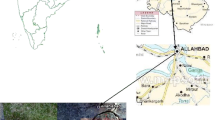Abstract
Due to inappropriate agricultural management practices, soil erosion is becoming one of the most dangerous forms of soil degradation in many olive farming areas in the Mediterranean region, leading to significant decrease of soil fertility and yield. In order to prevent further soil degradation, proper measures are necessary to be locally implemented. In this perspective, an increase in the spatial accuracy of remote sensing datasets and advanced image analysis are significant tools necessary and efficient for mapping soil erosion risk on a fine scale. In this study, the Revised Universal Soil Loss Equation (RUSLE) was implemented in the spatial domain using GIS, while a very high resolution satellite image, namely a QuickBird image, was used for deriving cover management (C) and support practice (P) factors, in order to map the risk of soil erosion in Kolymvari, a typical olive farming area in the island of Crete, Greece. The results comprised a risk map of soil erosion when P factor was taken uniform (conventional approach) and a risk map when P factor was quantified site-specifically using object-oriented image analysis. The results showed that the QuickBird image was necessary in order to achieve site-specificity of the P factor and therefore to support fine scale mapping of soil erosion risk in an olive cultivation area, such as the one of Kolymvari in Crete. Increasing the accuracy of the QB image classification will further improve the resulted soil erosion mapping.
Similar content being viewed by others
References
Baatz, M., Benz, U., Dehghani, S., Heynen, M., Holtje, A., Hofmann, P., et al. (2002). eCognition user’s guide. Munchen: Definiens Imaging GmbH: Digital.
Baourakis, G., Drakos, P., Karydas, C., Papadantonakis, N., & Stamataki, E. (2003). Setting up and implementation of sustainable and multifunctional rural development model based on organic and competitive agriculture. Chania: Mediterranean Agronomic Institute of Chania.
Beaufoy, G. (2000). The environmental impact of olive oil production in European Union. European Forum on Nature Conservation and Pastoralism, pp. 73.
Blaschke, T., Lang, S., & Moller, M. (2005). Object-based analysis of remote sensing data for landscape monitoring: Recent developments. In Anais XII Simpósio Brasileiro de Sensoriamento Remoto, Goiânia, Brasil, 16–21 Abril 2005 (pp. 2879–2885). Brazil: INPE.
Burrough, P. A. (1986). Principles of geographical information systems for land resources assessment. New York: Oxford University Press.
Chmelova, R., & Sarapatka, B. (2002). Soil erosion by water: Contemporary research methods and their use. Geographica, 37, 23–30.
Gobin, A., Kirkby, M., & Govers, G. (1999). Pan-European soil erosion risk assessment. http://perswww.kuleuven.ac.be/~u0001760/PESERA/PESERA.htm.
Gomez, J. A., Batani, M., Renschler, C. S., & Fereres, E. (2003). Evaluating the impact of soil management on soil loss in olive orchards. Soil Use and Management, 19(2), 127–134.
Karydas, C. G., Sekuloska, T., & Sarakiotis, I. (2005a). Fine scale mapping of agricultural landscape features to be used in environmental risk assessment in an olive cultivation area. IASME Transactions, 2(4), 582–589.
Karydas, C. G., Sekuloska, T., & Sarakiotis, I. (2005b). Use of imagery to indicate landscape features important when assessing environmental risk caused by olive farming and olive oil production. In Proceedings of 2005 IASME/WSEAS International Conference on Energy, Environment, Ecosystems and Sustainable Development. Athens: Polytechnic School of Athens.
Lueder, R. R. (1959). Aerial photographic interpretation. Principles and applications. New York: McGraw-Hill.
Moore, I. D., Grayson, R. B., & Ladson, A. R. (1991). Digital terrain modelling: A review of hydrological, geomorphological, and biological application. Hydrological Processes, 5, 3–30.
Morgan, R. P. C. (1995). Soil erosion and conservation. Harlow: Longman.
Schmidt, F., & Persson, A. (2003). Comparison of DEM data capture and topographic wetness indices. Precision Agriculture, 4(2), 179–192.
Silleos, N. G. (1990). Mapping and evaluation of agricultural lands. Thessaloniki: Giahoudi-Giapouli.
Silleos, N. G. (2000). Introduction to remote sensing and geographical information systems. Thessaloniki: Giahoudi-Giapouli.
Strand, G.-H., Dramstad, W., & Engan, G. (2002). The effect of field experience on the accuracy of identifying land cover types in aerial photographs. International Journal of Applied Earth Observation and Geoinformation, 4, 137–146.
Trojacek, P., & Kadlubiec, R. (2004). Detailed mapping of agricultural plots using satellite imagers and aerial orthphoto maps. In R. Goossens (Ed.) Remote sensing in transition (pp. 253–257). Rotterdam: Millpress.
Yang, C.-C., Prasher, S. O., Landry, J.-A., & Ramaswamy, H. S. (2003). Development of an image processing system and a fuzzy algorithm for site-specific herbicide applications. Precision Agriculture, 4(1), 5–18.
Author information
Authors and Affiliations
Corresponding author
Rights and permissions
About this article
Cite this article
Karydas, C.G., Sekuloska, T. & Silleos, G.N. Quantification and site-specification of the support practice factor when mapping soil erosion risk associated with olive plantations in the Mediterranean island of Crete. Environ Monit Assess 149, 19–28 (2009). https://doi.org/10.1007/s10661-008-0179-8
Received:
Accepted:
Published:
Issue Date:
DOI: https://doi.org/10.1007/s10661-008-0179-8




